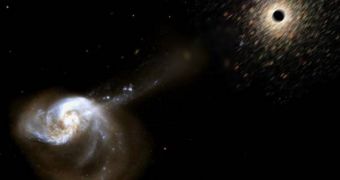Astronomers have recently discovered a new method of determining the speed and conditions under which supermassive black holes get thrown out of their host galaxies, when the formations collide with others, and the new black hole is larger than the first “inhabitant” of the galactic core. An international team of experts has determined that, by analyzing the speed and other properties of tight stellar clusters orbiting the expelled black holes, they can “reverse-engineer” the original conditions of the expulsion via computer models.
Experts David Merritt (Rochester Institute of Technology – RIT), Jeremy Schnittman (Johns Hopkins University), and Stefanie Komossa (Max-Planck-Institute for Extraterrestrial Physics, in Germany) say that, when the black hole is thrown out of its host galaxy, it travels towards the rim and beyond at a very high speed, ripping apart stars in the process, and carrying them with it. They also reveal that those stars that were located very close to the black hole's trajectory became locked with the dangerous structure, and took an orbit of sorts around it.
At this point, they still travel together, and the research demonstrates that, by analyzing the speed that the tight clusters around the black holes have, the original conditions that existed as the black hole was thrown out can be recreated. “You can measure how big the kick was by measuring how fast the stars are moving around the black hole. Only stars orbiting faster than the kick velocity remain attached to the black hole after the kick. These stars carry with them a kind of fossil record of the kick, even after the black hole has slowed down. In principle, you can reconstruct the properties of the kick, which is nice because there would be no other way to do it,” Merrit, an RIT physics professor, shares.
He also argues that the triggers for such an expulsion are always black hole mergers, which occur when, for example, two galaxies collide. As such, it may be that the nearby Coma and Virgo clusters, each made up of thousands of galaxies merging with each other for many million years, may be the best place to start investigating for such formations. “Even if the black hole gets kicked out of one galaxy, it's still going to be gravitationally bound to the whole cluster of galaxies. The total gravity of all the galaxies is acting on that black hole. If it was ever produced, it's still going to be there somewhere in that cluster,” the researcher adds.
“The only contact of these floating black holes with the rest of the universe is through their armada of stars, with an occasional display of stellar fireworks to signal 'here we are,'” Merrit states.

 14 DAY TRIAL //
14 DAY TRIAL //